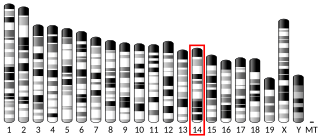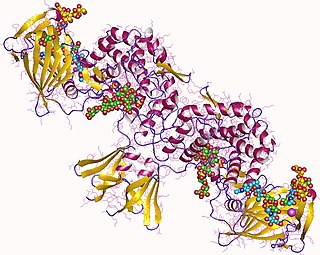
Glucuronolactone is a naturally occurring substance that is an important structural component of nearly all connective tissues. It is sometimes used in energy drinks. Unfounded claims that glucuronolactone can be used to reduce "brain fog" are based on research conducted on energy drinks that contain other active ingredients that have been shown to improve cognitive function, such as caffeine. Glucuronolactone is also found in many plant gums.
Glucono-delta-lactone (GDL), also known as gluconolactone, is a food additive with the E-number E575 used as a sequestrant, an acidifier, or a curing, pickling, or leavening agent. It is a lactone of D-gluconic acid. Pure GDL is a white odorless crystalline powder.

L-Gulonolactone oxidase is an enzyme that produces vitamin C, but is non-functional in Haplorrhini, in some bats, and in guinea pigs. It catalyzes the reaction of L-gulono-1,4-lactone with oxygen to form L-xylo-hex-3-gulonolactone (2-keto-gulono-γ-lactone) and hydrogen peroxide. It uses FAD as a cofactor. The L-xylo-hex-3-gulonolactone then converts to ascorbic acid spontaneously, without enzymatic action.

6-Phosphogluconolactonase (EC 3.1.1.31, 6PGL, PGLS, systematic name 6-phospho-D-glucono-1,5-lactone lactonohydrolase) is a cytosolic enzyme found in all organisms that catalyzes the hydrolysis of 6-phosphogluconolactone to 6-phosphogluconic acid in the oxidative phase of the pentose phosphate pathway:

Heparosan-N-sulfate-glucuronate 5-epimerase is an enzyme with systematic name poly( -beta-D-glucuronosyl- -N-sulfo-alpha-D-glucosaminyl) glucurono-5-epimerase. This enzyme catalyses the following chemical reaction
In enzymology, a D-threo-aldose 1-dehydrogenase (EC 1.1.1.122) is an enzyme that catalyzes the chemical reaction
In enzymology, a D-xylose 1-dehydrogenase (NADP+) (EC 1.1.1.179) is an enzyme that catalyzes the chemical reaction
In enzymology, a glucuronolactone reductase (EC 1.1.1.20) is an enzyme that catalyzes the chemical reaction
In enzymology, an uronate dehydrogenase (EC 1.1.1.203) is an enzyme that catalyzes the chemical reaction
In enzymology, a L-galactonolactone oxidase (EC 1.3.3.12) is an enzyme that catalyzes the chemical reaction

Camptothecin (CPT) is a topoisomerase inhibitor. It was discovered in 1966 by M. E. Wall and M. C. Wani in systematic screening of natural products for anticancer drugs. It was isolated from the bark and stem of Camptotheca acuminata, a tree native to China used in traditional Chinese medicine. It has been used clinically more recently in China for the treatment of gastrointestinal tumors. CPT showed anticancer activity in preliminary clinical trials, especially against breast, ovarian, colon, lung, and stomach cancers. However, it has low solubility and adverse effects have been reported when used therapeutically, so synthetic and medicinal chemists have developed numerous syntheses of camptothecin and various derivatives to increase the benefits of the chemical, with good results. Four CPT analogues have been approved and are used in cancer chemotherapy today: topotecan, irinotecan, belotecan, and trastuzumab deruxtecan. Camptothecin has also been found in other plants including Chonemorpha fragrans.
In enzymology, a D-arabinono-1,4-lactone oxidase (EC 1.1.3.37) is an enzyme that catalyzes the chemical reaction
In enzymology, a glucose 1-dehydrogenase is an enzyme that catalyzes the chemical reaction
In enzymology, a quinoprotein glucose dehydrogenase is an enzyme that catalyzes the chemical reaction
The enzyme limonin-D-ring-lactonase (EC 3.1.1.36) catalyzes the reaction
In enzymology, a glucuronate-2-sulfatase is an enzyme that catalyzes the chemical reaction of cleaving off the 2-sulfate groups of the 2-O-sulfo-D-glucuronate residues of chondroitin sulfate, heparin and heparitin sulfate.
In enzymology, a glucuronokinase is an enzyme that catalyzes the chemical reaction

Lactonase (EC 3.1.1.81, acyl-homoserine lactonase; systematic name N-acyl-L-homoserine-lactone lactonohydrolase) is a metalloenzyme, produced by certain species of bacteria, which targets and inactivates acylated homoserine lactones (AHLs). It catalyzes the reaction
Acyl-homoserine-lactone acylase (EC 3.5.1.97, acyl-homoserine lactone acylase, AHL-acylase, AiiD, N-acyl-homoserine lactone acylase, PA2385 protein, quorum-quenching AHL acylase, quorum-quenching enzyme, PvdQ, QuiP) is an enzyme with systematic name N-acyl-L-homoserine-lactone amidohydrolase. This enzyme functions as a quorum quencher by catalysing the following chemical reaction

Lipase inhibitors belong to a drug class that is used as an antiobesity agent. Their mode of action is to inhibit gastric and pancreatic lipases, enzymes that play an important role in the digestion of dietary fat. Lipase inhibitors are classified in the ATC-classification system as A08AB . Numerous compounds have been either isolated from nature, semi-synthesized, or fully synthesized and then screened for their lipase inhibitory activity but the only lipase inhibitor on the market is orlistat . Lipase inhibitors have also shown anticancer activity, by inhibiting fatty acid synthase.







